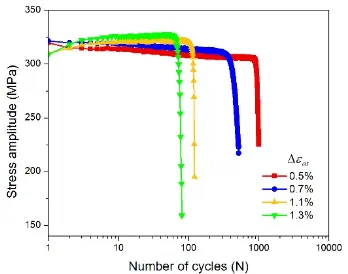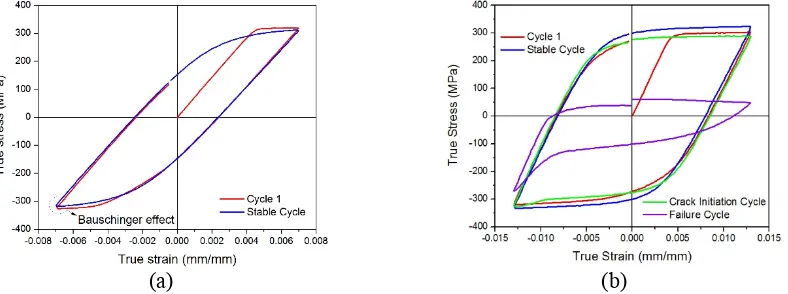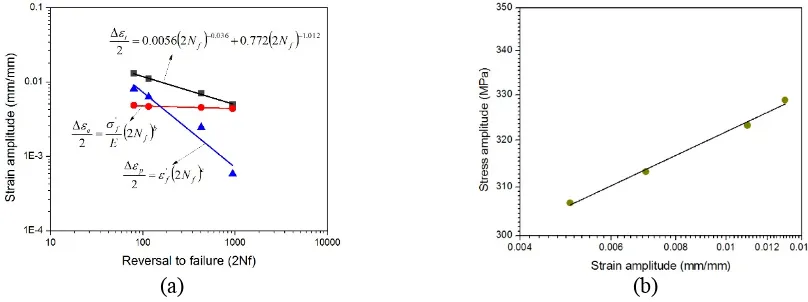Low Cycle Fatigue Properties of Extruded 6061-T6
Aluminum Alloy
Mohammad Badaruddin
a), Zulhanif, Harnowo Supriadi
Department of Mechanical Engineering, Faculty of Engineering, Universitas Lampung Jalan Prof. S. Brojonegoro No. 1 Bandar Lampung 35145, Indonesia
a)Corresponding author: [email protected]
Abstract. This paper presents the low cycle fatigue properties of extruded 6061 aluminum alloy. The cyclic strain-controlled fatigue tests were performed under fully reversed total with a strain amplitudes (0.51.3%) at a fixed strain rate (0.004 s1) using smooth specimens
cyclically loaded along with the extrusion directions. The fatigue test results represented by the hysteresis curves of stress-strain show slight Bauschinger effect at a total strain amplitude (at) 0.7 %. At strain amplitudes 0.7% the alloy significantly experienced cyclic softening and in the strain amplitude ranging from 1.1 to 1.3 %, the alloy experienced cyclic hardening until the alloy failed. The corresponding cyclic stress response during fatigue loading revealed that cyclic softening occurred, particularly at the lower strain amplitudes and vice versa, at higher strain amplitudes the material experienced cyclic hardening. The strain-fatigue life models were empirically determined by the Coffin-Manson-Basquin relationships.
1.
IntroductionRecently, Industrial aerospace and automotive are most developing lightweight-alloy designs concept to increase an efficiency in use of fossil fuel consumptions. Alternatively, an aluminum 6061 alloy is mainly chosen as structural components because the alloy has high strength, good machinability, corrosion resistance, low coefficient of thermal expansion and good abrasion resistance [1-2]. The Al-6061 alloy is an aluminum-silicon-magnesium alloys that has good strength and very high formability and therefore the alloy is most manufactured by extruding process into complex geometries like multi-hollow bodies [3,4]. This makes a 6061 aluminum alloy in which very adaptable for use in the form of plates, extrusions, foils, sheets, pipes, forgings, and even structural forms in the aerospace, construction, and transportation industries [5]. The structural engineering of the 6061 alloy involves a cyclic loading due to the fact that structural components in a vehicles experience dynamic loading, thus leading to higher plastic deformation which results in the occurrence of low cycle fatigue failure [6]. Hence, an understanding of low cycle fatigue properties of 6061-T6 alloy is essential for design and analysis of engineering components.
and in other published in a journal [9]. Mirza et al. [8] conducted the low cycle fatigue of extruded
6061-T6 aluminum alloy using a highest 1.2% strain amplitude and a strain rate 0.01 s-1. Furthermore,
A similar tests were conducted by Brammer et al. [9] using a fixed frequency of 5 Hz under different strain amplitudes. Existing low-cycle fatigue properties of 6061-T6 aluminum alloy describes that fatigue life of the alloy is significantly affected by strain amplitude, strain rate and frequency. Therefore, the purpose of the present study is to determine low cycle fatigue properties of an extruded 6061-T6 aluminum alloy under various higher strain amplitudes, i.e., 0.5–1.3% at strain rate of 0.004
s1. The present results are compared with results reported in Ref. [8,9].
2. Experimental procedure
A commercial extruded 6061-T6 aluminum alloy in a round bar with 20 mm in diameter and 150 mm in length was machined using CNC EMCO Turning machine for providing tensile and low cycle fatigue (LCF) specimens according to ASTM B557 [10] and ASTM E606 standards [11], respectively. The diameter and the total gage length of the tensile specimens were 6 mm and 40 mm, respectively. LCF specimens had the diameter of 6.35 mm with the total gage length 30 mm. Prior to testing, all specimens were hand ground in the loading direction with 800-grit silicon carbide paper to remove residual stresses and any machining marks. Tensile tests were performed in accordance with the ASTM E8 standard [12] by means of a computerized MTS Landmark 100 kN servo-hydraulic testing system with an axial extensometer gauge length of 10 mm (Model: 632.13F-20 MTS) using control of
a strain rate of 0.5% min−1 from starting test to yield point determination and later a displacement rate
of 0.25 mm min1 controlled the testing until specimen broke at room temperature. The LCF tests were
conducted in accordance with the ASTM E606 standard at room temperature with 632.13F-20 MTS extensometer as strain-based control using a fully computerized MTS Landmark 100 kN servo-hydraulic testing system operated by Multipurpose LCF software. The cyclic loading tests consisted of a strain ratio of R = −1 and a constant strain rate, (
ε
´
) of 0.004 s1 and total strain amplitude (at) of0.5, 0.7, 1.1 and 1.3% under triangular loading waveform. In this study, crack initiation cycle and
cycles to failure (Nf) were defined as the number of the cycle at which the maximum tensile load range
decreased by 10% and 25% from that in a stable and saturated region, respectively.
Figure 1. Cyclic stress amplitude versus number of cycles at different total strain amplitudes of extruded 6061-T6 aluminum alloy
3. Results and discussion
3.1. Cyclic stress response
of physical quantity that is generated by dynamically obstructing dislocation movements as result of coupling effects between internal microstructures and particle phase precipitations (Mg2Si) [7].
Typical stress-strain hysteresis loops of the first, stable, crack initiation and failure cycles at a total strain amplitude of 0.7% and 1.3% are displayed in Figs. 2a and 2b, respectively. The tensile and compressive stress were resulted by a cyclic loading at the first cycle which is slight higher than the tensile and compressive stress resulted until a stable cycles leading to softening behaviour of the alloy (Fig. 2a). In addition, the current 6061-T6 aluminum alloy is also observed to exhibit unsymmetrical hysteresis loops with only a slight downward shift in compression (Fig. 2a) at the first cycle until stable cycles. This phenomenon was similar to most of the face-centered cubic (FCC) metals as a consequence of the obstacle dislocation movement that however, generated plastic deformation in most ductile materials [14]. It is clearly observed in Fig 2a that slight unsymmetrical compressive stress tips yields a phenomenon in the alloy that distinguishes as the Bauschinger-like effect [15]. When the alloy experiences a loading in the compressive direction, the dislocations resulted are not able to inhibit the reversed stresses, thus leading to small dislocation annihilation. Consequently, the further cycles generates the initial softening of the alloy. The Bauschinger effect was not found in the alloy during low cycle fatigue tests for a higher strain amplitude of 0.7%, as shown in Fig. 2b. Fig. 2b shows that during cyclic loading, the higher strain amplitude generates a larger size of the hysteresis loop of the alloy that indicates a larger portion of plastic region.
(a) (b)
Figure 2. Typical stress-strain hysteresis loops of different cycles of the extruded
6061-T6 aluminum alloy tested at
ε = 0.004 s
´
1 and total strain amplitude: (a) 0.7%, (b) 1.3 %Fig. 3a shows cyclic softening within the half of cycles failure at strain amplitudes of 0.5–0.7%, which is contrast to the result reported for the extruded 6061-T6 aluminum alloy in Ref. [8,9]. It indicates that at a lower strain amplitude of 0.7%, the extruded 6061-T6 aluminum alloy tends to
softening behavior where the secondary phase particles (Mg2Si) in the alloy are not able to retain the
movement of dislocations, thus leading to dislocation annihilation until the alloy fail. Furthermore, at
the strain amplitude 0.7%, the alloy behaves strain hardening with increasing strain amplitudes (Fig.
3a). In the strain amplitudes ranging from 1.1%1.3%, the initial hardening experienced by the alloy
can be attributed to interaction between the presence of small size secondary phase particles and
Mg2Si-precipitates for obstructing the dislocation movement [16].
The variation of the strain amplitude corresponding to reversal to failure cycles is shown in Fig. 4a, which corresponded well to the change of the stress amplitude during cyclic deformation as shown in Fig. 3b at different total strain amplitudes. As shown in Fig. 2b, as the higher strain amplitudes increased the plastic strain amplitudes but consequently, fatigue life of the alloy was decreased. As noted for monotonic loading, the extruded aluminum alloy showed lower stress responses under
cyclic loading at strain amplitude 1.1%, as shown in Fig. 3b.
σ
a=
K
'(
ϵ
ap)
n'
(1)
where Δσa and Δεap are stress amplitude and plastic strain amplitude at a half-life cycles, respectively.
The n′ is the cyclic strain-hardening exponent and K is the cyclic strength coefficient that obtained
using curve fitting by plotting a double log-Δσa versus Δεap curve.
(a) (b)
Figure 3. (a) Effect of strain amplitude on the cyclic softening and hardening, (b) Stress-strain curve of extruded 6061-T6 aluminum alloy
3.2. Fatigue life and fatigue parameters
Figure 4a displays the total strain amplitude Δεt as a function of the number of cycles to failure (Nf,
i.e., fatigue life) for the extruded 6061-T6 aluminum alloy. The alloy shows a trend of increasing fatigue life with decreasing strain amplitude and overall the material basically shows an improved fatigue life than the extruded 6061-T6 aluminum alloys reported in the literatures [8,9]. This phenomenon is closely related with material strength and ductility. In addition, the alloy experiences higher ductility and lower strength (Fig. 3b) which lead in better fatigue resistance at a lower strain amplitude.
(a) (b)
Figure 4. (a) A typical strain amplitude-failure cycle curve and (b) plastic strain-stress relationship curve of extruded 6061-T6 aluminum alloy
The low cycle fatigue properties of extruded 6061-T6 aluminum alloy were determined by the Basquin-Coffin-Manson relationship in form of Eq. (2).
∆ ε
t=
∆ ε
ae+
∆ ε
ap=
σ
f 'E
(
2
N
f)
bwhere E is the Young’s modulus (for the present material the average value obtained during fatigue
testing was 67.0 GPa), Nf is the fatigue life or the number of cycles to failure,
σ
f'(MPa) is the fatiguestrength coefficient, b is the fatigue strength exponent, ϵf' is the fatigue ductility coefficient, and c is
the fatigue ductility exponent. Fig. 4a displays the elastic, plastic, and total strain amplitudes as a
function of the number of reversals to failure (2Nf). In addition, the empirical models which are the
Basquin-Coffin-Manson’s equation approach show good correlations with the test data, as shown in Fig. 4a. In order to ensure that cyclic stabilization, also called cyclic saturation had already occurred in the alloy, the stress amplitude and plastic strain amplitude values at the half-life cycles were used (Fig. 4b). Hence, the fatigue life parameters obtained by means of Eqs. (1) and (2) were presented in Table 1, regarding comparisons between the strain-life properties determined in this study and the strain-life properties determined in previous studies in literatures, show that the LCF parameters determined using Eq. (2) shows a significant differences in fatigue strength, cyclic strength, cyclic strain
hardening and fatigue ductility coefficient values. However, the cyclic strain hardening exponent (n)
and the fatigue ductility exponent (c) are almost identical with the values reported by Mirza et al. [8] and Brammer et al. [9] in their previous research. These differences in the Coffin-Manson approach suggest that there is slightly more plastic strain effect below a 1.1% strain amplitude in the extruded material. However, it can be seen that the obtained fatigue parameters were well within the range.
Both of K′ value and n′ are obtained from plot of double logarithmic stress versus strain amplitude
(Fig. 4b). The obtained cyclic strain hardening exponent (n′ = 0.072) of the present 6061-T6 aluminum
alloy was higher than the corresponding monotonic strain hardening exponent (n= 0.024), as can be
seen in Table 1. This could be the main reason why this alloy exhibited cyclic hardening even at higher strain amplitude of 1.3%. The comparison LCF parameters of the present research with the literatures [8,9] are completely displayed in Table 1.
Table 1. Low cycle fatigue parameters of the extruded 6061-T6 aluminum alloy
LCF Parameters Extruded 6061-T6 aluminum alloyPresent study Ref. [7] Ref. [8]
Cyclic strength coefficient, K
Fatigue strength coefficient, σf', MPa
Cyclic strain hardening exponent, n
Fatigue strength exponent, b
Fatigue ductility coefficient,
ϵ
f', mm/mmFatigue ductility exponent, c
Strain-controlled fatigue tests were conducted on an extruded 6061 aluminum alloy with various strain amplitudes at strain rate 0.004 s1. The stress-strain responses exhibited essentially unsymmetric
responses as a consequence of the obstacle dislocation slip-dominated plastic deformation with
Bauschinger effect. The alloy experiences softening behavior at strain amplitudes 0.7%. At strain
amplitudes 0.7%, the alloy has started to experience cyclic hardening until reaching cyclic
stabilization and failure. It indicates that from the corresponding cyclic stress response during fatigue loading revealed that cyclic hardening particularly occurred at a higher strain amplitudes of 0.7%. The low cycle fatigue parameters of the present extruded 6061-T6 aluminum alloy was observed to be a significant differences compared with the other extruded 6061 aluminum alloys reported in literatures due to the fact that the behavior of low cycle fatigue of the alloy significantly is affected by strain amplitude and strain rate. In addition, the strain-life models determined by adequately approaching the Basquin-Coffin-Manson relationship show good correlation to strain-controlled fatigue test data.
The authors would like to thank the Ministry Research, Technology and Higher Education of Republic of Indonesia, through the Fundamental Research grant in fiscal year of 2017-2018.
References
1. Okayasu M, Ohkura Y, Takeuchi S, Takasu S, Ohfuji H and Shiraishi T 2012 Mater. Sci. Eng. A
543 185.
2. Ammar HR, Samuel AM and Samuel FH 2008 Intl. J. Fat.30 1024.
3. Fan KL, He GQ, Liu XS, Liu B, She M, Yuan YL, Yang Y and Lu Q 2013 Mater. Sci. Eng. A
586 78.
4. Takahashi Y, Yoshitake H, Nakamichi R, Wada T, Takuma M, Shikama T and Noguchi H 2014
Mater. Sci. Eng. A614 243.
5. Takahashi Y, Shikama T, Nakamichi R, Kawata Y, Kasagi N, Nishioka H, Kita S, Takuma M and
Noguchi H 2015 Mater. Sci. Eng. A641 263.
6. Takahashi Y, Shikama T, Yoshihara S, Aiura T and Noguchi H 2012 Acta Mater. 60 2554.
7. Li WA, Li ZY, Shuai H, Xiao SH, Yong Z 2017 Intl. J. Fat. 95 216.
8. Odeshi AG, Adesola AO and Badmos AY 2013 Eng. Fail Anal.35 302.
9. Mirza FA, Liu K and Chen XG 2017 Cyclic stress-srain behavior and low cycle fatigue life of
AA6061 aluminum alloy. In: Ratvik A. (eds) Light Metals 2017. The Minerals, Metals &
Materials Series. Springer, pp. 447452.
10. Brammer AT, Jordon JB, Allison PG and Barkey ME 2013 J. Mater. Eng. Perform. 22 1348.
11. ASTM B557-15 Standard test methods for tension testing wrought and cast aluminum- and magnesium-alloy Products, ASTM International, West Conshohocken, PA, 2015.
12. ASTM E 606-04 Standard practice for strain-controlled fatigue testing, ASTM International, West Conshohocken, PA, 2004.
13. ASTM E8/E8M Standard test methods for tension testing of metallic materials, ASTM International, West Conshohocken, PA, 2016.
14. Jordon JB, Horstemeyer MF, Solanki K and Xue Y 2007 Mech. Mater. 39 920.
15. Zuhair MG and Syed SA 2013 Mater. Sci. Eng. A562 109.



